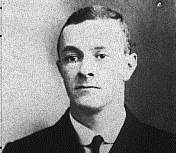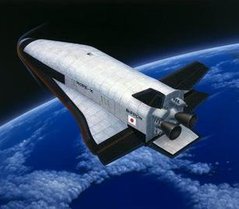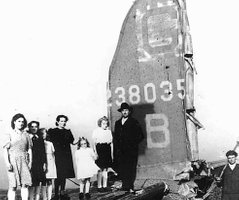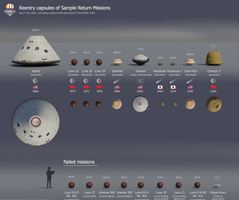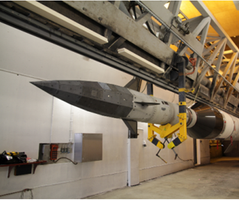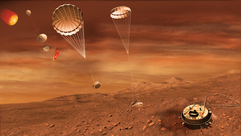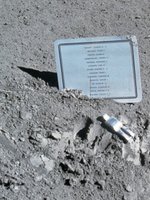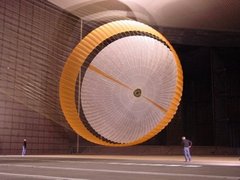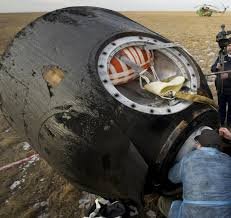Blog posts
Because not all interesting topics can be discussed per parachute mission or destination we have blog posts. These blogposts are centred around parachute related topics. If you have a suggestion for a blog post, let us know!
Falling: Amazing survival stories
The following blog post has been written by Jim Hamilton from the Free Fall Research Page.
Testing for HOPE
In 1986 Japan was looking at their future in space flight. This future called for independence and access to space. This was to be done using the spaceplane called "H2 Orbiting Plane" or HOPE. This mission was supported by several smaller experiments called the ALFLEX (Automatic Landing Flight EXperiment), HYFLEX (Hypersonic Flight Experiment), and HSFD (High-Speed Flight Demonstration) missions.
Evolution of the Disk Gap Band Parachutes for Mars US missions
From the first Viking lander to the last Mars Rover the US robotic Martians have always descended safely under a Disk-Gap-Band parachute. The Disk Gap Band parachute is one of the oldest and simplest forms of the parachute.
The flying Sailor
The following blog post has been written by Jim Hamilton from the Free Fall Research Page.
A short, animated film called “The Flying Sailor” has been nominated for an Academy Award. It tells the story of Charles Mayers, a British sailor who was in Halifax, Nova Scotia on December 6, 1917, the day that a cargo ship full of volatile materials intended for the war effort collided with another ship and exploded after bursting into flames. The force of the blast levelled parts of the town, bringing misery and destruction to Halifax and its surroundings. 1,782 people were killed and approximately 9,000 others were injured.
Long Free Survival
The following blog post has been written by Jim Hamilton from the Free Fall Research Page.
I began collecting long-fall survival stories more than twenty years ago. At the time, I was researching a group of journalists called “The Writing 69th” who covered the 8th Air Force’s activities out of England during World War II. One of the first stories I encountered concerned an American tail gunner named Joe Jones who survived a fall of more than 13,000 feet in the severed tail of his B-17 bomber.
When are you in space
With the flight of Richard Branson onboard the VSS Unity the discussion on what is space has been more intense than ever. This blog post aims not to finish the discussion but to provide insight into what the various altitude means.
Sample Return Missions
Sample return missions are, as the name suggests missions that return a sample of space. Examples include Genisis and Hayabusa, these missions are described here. Another sample return mission, maybe even the most famous sample return mission, was Apollo. Sample return missions are difficult as their mission architecture usually includes several landings and, for more complicated missions, different spacecraft. This blog post dives into the challenges of sample return missions.
Gemini recovery design concepts
During the early ‘60s, project Gemini was tasked to develop and test the technologies that would enable the United States to place humans on the moon … and to get them back safely. Gemini would form the bridge between project Mercury and project Apollo during the space race. Gemini faced engineering challenges that had never been faced before, leading to many design concepts that are considered non-conventional by today’s standards. This was especially true for the entry descent and landing (EDL) system design, for which there was no lack of creativity.
Transpiration cooling for re-entry vehicles
Ever since the first probes came back from space, engineers and scientists have been looking for methods to deal with the high heat loads associated with high-speed reentry environments. Throughout the years, many different technologies have been developed to improve the survivability of reentry: advancements in high-temperature materials, improved simulation programs, and the development of active cooling systems. Under the latter category falls transpiration cooling, which has been used for active cooling of aerospace components such as rocket engine thrust chambers, turbine blades, and reentry vehicles.
Early progress towards US ballistics recovery
During the midst of the Cold War in the early ‘70s, the United States Air Force (USAF) had a strong interest in further developing its ballistic missile capabilities. One of the major challenges that had to be tackled, was to gain a better understanding of the aerothermal heating experienced by the ballistic vehicles during re-entry. The US had already proven that it was capable to return vehicles from space in the previous decade, during the Mercury, Gemini, Apollo and unmanned missions, however, these ballistic re-entry vehicles were of a different category. The large ballistic coefficient, high speed and steep descent profile caused extreme heat loads, higher than those experienced by any other types of re-entry vehicles, especially when the range (and thus speed) of intercontinental missiles was ever-increasing.
Exceptional Parachutes
Parachutes have been used for space missions for over 60 years. Some of these parachute designs have been pushing the limits of what is technically feasible. This page provides an overview of some exceptional and record-breaking parachutes that have flown for space missions. Parachutes used for aircraft, supply drops, recreational use and similar are not included in this list as these are outside of the scope of chutes.nl.
New Shepard's parachutes
The New Shepard rocket of Blue Origin is a suborbital crewed capsule targeting both the research and tourism market. Like most companies, Blue Origin is quite secretive about their parachute sizes and performance. Therefore Chutes.nl set out to reverse engineer the size of New Glenn's parachutes.
Comparison of crewed capsules
Those who have followed the developments in crewed space flight might have noticed that there are quite some differences between the operational capsules. Where the Crew Dragon has four large main parachutes, the Soyuz capsule only has one. It is not weird for people to ask why this is the case.
Heritage in parachute systems
The development of a new parachute system is expensive, time-consuming and labour-intensive. Therefore, EDL engineers will often base the recovery system’s design on flight-proven hardware of previous missions or even use an exact copy. The decision to use an existing system instead of a newly developed one can follow from a trade-off, where factors such as system mass, cost, development time and risk play a major role.
When EDL systems fail
EDL systems are challenging and have a relatively high failure rate as opposed to other spacecraft subsystems. This is largely due to the extreme conditions and uncertainty that comes along with them. Failure of an EDL system can, unfortunately, leads to the death of the crew.
Ballutes
The word ballute is a conjunction of 'balloon' and 'parachute'. As the name implies, ballutes are balloon-shaped, however, they perform the same function as parachutes: deceleration or stabilization of a vehicle in an atmosphere. Ballutes have the advantage that they offer great performance at high Mach numbers, where most other parachutes fail.
Testing of parachute systems
The testing of a parachute system is done in advance of a flight. These tests combine all the environments a parachute system should be able to handle. There are several ways one can test a parachute system ranging from frequently used to somewhat experimental.
Reliability, Redundancy and back up systems
When designing and building a complex space system, especially when talking about crewed space flight, one aims for a reliability "as high as possible". When looking at the NASA commercial crew program, the probability of loss of crew is set to 1/270 for the overall mission and a 1/1000 probability for both the ascend and descend phase. The loss of mission is lower and set to 1/52. There is a significant difference between loss of mission and loss of crew. When the launch escape system is activated as was the case with Soyuz MS-10 he mission is lost, but the crew is not. This brings us to the difference between the different terms: Reliability, redundancy and backup systems.
In-flight abort systems
When things go wrong during ascend, the crew needs to be able to remove themselves from a failing rocket. Launch escape systems have to operate at the highest dynamic pressures and the toughest conditions. This blog post is on how the design of the parachute system is influenced by the inclusion of a launch escape system.
Comparison of the Apollo and Orion EDL systems
In 1969 the US set the first two human beings on the moon. Days later on July 24th Armstrong, Aldrin and Collins entered the earth's atmosphere and landed safely in the north pacific ocean at 16:50 UTC. Soon a new set of moon missions will lift off under the Artemis project. Even though the objectives of these missions are quite different, their entry descent and landing profile are quite comparable.

